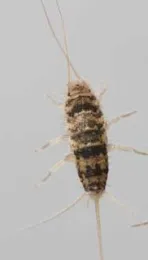Groundbreaking Research: Odorant Receptor Genes Found in Wingless Insect
(Embargo lifts at 5 a.m. Pacific Time, July 31, 2018)

There they were--odorant receptor genes, the scent-detecting genes thought to have evolved with winged insects more than 400 million years ago. But this groundbreaking discovery indicates they evolved millions of years earlier.
The sensory gene is considered one of an insect's most important genes, crucial to foraging, mating and avoiding predators.
“It was interesting because a paper published in 2014 claimed that ORs evolved with winged flight and were thus absent in ancestrally wingless (Apterygota) insects,” said Brand, a member of the Population Biology Graduate Group who researches the evolution of olfactory/odorant receptor genes in orchid bees. “Since firebrats are apterygote, we now had proof that this gene family is more ancient than previously thought.”

Brand proposed that they merge their datasets and write a comprehensive paper of higher impact rather than two independent papers. It was a “go.”
The collaborative result: “The Origin of the Odorant Receptor Gene Family in Insects,” a newly published paper by a seven-member team from UC Davis, University of Illinois and the University of Tennessee, in the open-access journal eLife, which prints promising research in the life and medical sciences. The article is online at https://doi.org/10.7554/eLife.38340
“Our finding that the odorant receptor gene family evolved at the evolutionary base of the insects makes it a major evolutionary novelty that presumably contributed to the adaptation of early insects to terrestrial living,” Robertson said.
Said Brand: “Odorant receptors are the largest insect gene family underlying the sense of smell. ORs are thus crucial in the majority of behaviors that involve the sense of smell including foraging, reproduction, and detection of predators.” The cell membranes of odorant receptor neurons are key to detecting scents. In insects, the ORs are usually found in the antennae or mouthparts.

In their abstract, the authors wrote that “The origin of the insect odorant receptor (OR) gene family has been hypothesized to have coincided with the evolution of terrestriality in insects. (Christine) Missbach et al. (2014) suggested that ORs instead evolved with an ancestral OR co-receptor (Orco) after the origin of terrestriality and the OR/Orco system is an adaptation to winged flight in insects. We investigated genomes of the Collembola, Diplura, Archaeognatha,
Zygentoma, Odonata, and Ephemeroptera, and find ORs present in all insect genomes butabsent from lineages predating the evolution of insects. Orco is absent only in the ancestrally wingless insect lineage Archaeognatha. Our new genome sequence of the zygentoman firebrat, Thermobia domestica, reveals a full OR/Orco system. We conclude that ORs evolved before winged flight, perhaps as an adaptation to terrestriality, representing a key evolutionary novelty in the ancestor of all insects, and hence a molecular synapomorphy for the Class Insecta.”
Synapomorphy is defined as a characteristic present in an ancestral species and shared exclusively by its evolutionary descendants.
The research is a UC Davis cross-departmental collaboration involving associate professor Brian Johnson of the Davis Department of Entomology and Nematology, Wei Lin of the Johnson lab and a member of the Entomology Graduate Group; and Brand, who studies with major professor Santiago Ramirez of the Department of Evolution and Ecology.
“A recurring theme in the field of genomics is that incomplete sampling of the relevant taxa often leads to premature conclusions,” said Johnson. “Our work on ORs is a good example of this.” Johnson studies the genetics, behavior, evolution, and health of honey bees. His lab currently focuses on the evolution and genetic basis of social behavior using comparative and functional genomics.”
The seven-member team, in addition to the UC Davis and University of Illinois scientists, included a trio from the University of Tennessee: Ratnasri Pothula, William Klingeman, and Juan Luis Jurat-Fuentes.
Brand recalled that he detected the multiple odorant receptor genes in the firebrat genome in late January or early February. “I was working at home after my normal work day, because this genome work I did with Brian was a side project for me—he knew of my interest in genomics and offered me the opportunity to collaborate on his lab's ongoing projects.”
Brand expects to receive his doctorate from UC Davis in the spring of 2019. A native of Germany and a former research scientist at Ruhr-University, Bochum, he received his master's degree in genetics and evolutionary biology in 2013 from Ruhr-University, and his bachelor's degree in biology in 2010 from Heinrich-Heine University, Düsseldorf, Germany.

Winged insects first appeared on earth 406 million years ago, according to research published in a 2014 edition Science by molecular biodiversity researcher Bernhard Misof, a professor at the University of Bonn, Germany.
Fossil records indicate that hexapods diverged from crustaceans 410 to 510 million years ago, according to Misof. “At this time in geological history, land masses were dotted with shallow inland seas, and plant life (mostly algae and bryophytes) was largely restricted to coastal habitats and other sites where water was readily available,” according to a North Carolina State University's Department of Entomology website. “The oldest hexapod fossils are found in rocks of the late Devonian period. These rocks also contain numerous other terrestrial arthropods (mites, spiders, centipedes, scorpions, etc.) suggesting that a major radiation of terrestrial life-forms must have occurred during the Ordovician or Silurian period.”
The first known fossil record of Apterygota insects, which include firebrats, silverfish and jumping bristletails—dates back to the Devonian period, which began 417 years ago.
The firebrat, found throughout the world under rocks and leaf litter, is an indoor pest of dog food, stored foods, fabric and book bindings. It is commonly found in high-humidity environments such as bakeries and boiler rooms.
According to the UC Statewide Integrated Pest Management Program (UC IPM), both firebrats and their cousin silverfish “have enzymes in their gut that digest cellulose, and they choose bookcases, closets, and places where books, clothing, starch, or dry foods are available. Silverfish and firebrats are nocturnal and hide during the day. If the object they are hiding beneath is moved, they will dart toward another secluded place. They come out at night to seek food and water. Both insects prefer dry food such as cereals, flour, pasta, and pet food; paper with glue or paste; sizing in paper including wallpaper; book bindings; and starch in clothing. Household dust and debris, dead insects, and certain fungi also are important sources of food. However, they can live for several months without nourishment.”
“Large numbers of these insects can invade new homes from surrounding wild areas, especially as these areas dry out during the summer,” the UC IPM website says. “They also can come in on lumber, wallboard, and similar products. Freshly laid concrete and green lumber supply humidity, while wallpaper paste provides food.”
Resources:
eLife: https://doi.org/10.7554/eLife.38340
UC IPM Pest Note on Firebrat: http://ipm.ucanr.edu/PMG/PESTNOTES/pn7475.html
Information on hexapods: https://genent.cals.ncsu.edu/bug-bytes/hexapods/
Philipp Brand website: https://evolvingors.wordpress.com
Contacts:
Philipp Brand: pbrand@ucdavis.edu
Brian Johnson: brnjohnson@ucdavis.edu
Hugh Robertson: hughrobe@uiuc.edu
